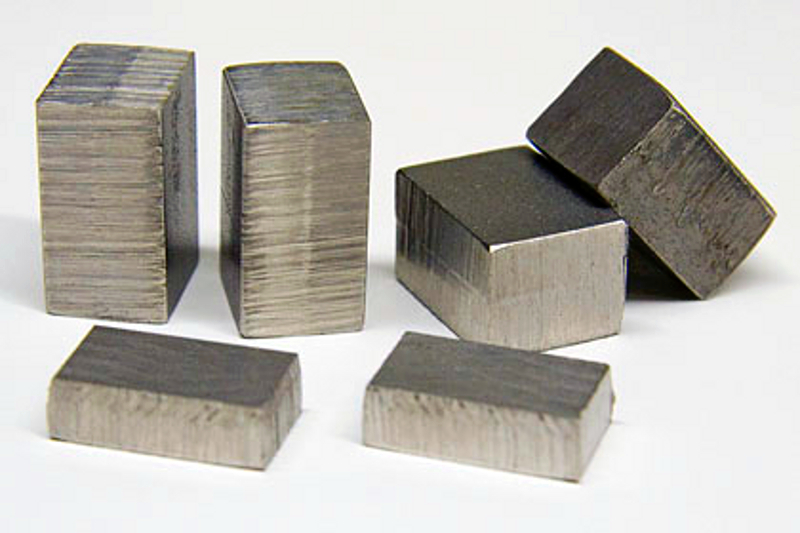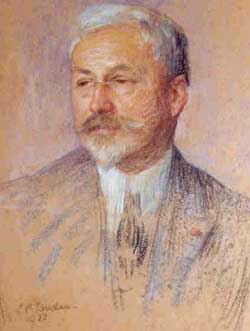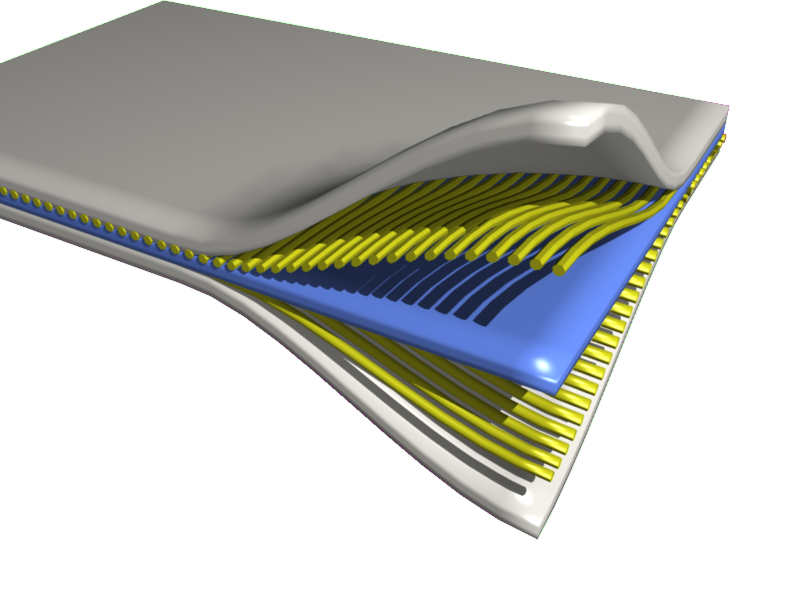|
Invar
Invar, also known generically as FeNi36 (64FeNi in the US), is a nickel–iron alloy notable for its uniquely low coefficient of thermal expansion (CTE or α). The name ''Invar'' comes from the word ''invariable'', referring to its relative lack of expansion or contraction with temperature changes. The discovery of the alloy was made in 1895 by Swiss physicist Charles Édouard Guillaume for which he received the Nobel Prize in Physics in 1920. It enabled improvements in scientific instruments. Properties Like other nickel/iron compositions, Invar is a solid solution; that is, it is a single-phase alloy. In one commercial version it consists of approximately 36% nickel and 64% iron. The invar range was described by Westinghouse scientists in 1961 as "30–45 atom per cent nickel". Common grades of Invar have a coefficient of thermal expansion (denoted α, and measured between 20 °C and 100 °C) of about 1.2 × 10−6 K−1 (1.2 ppm/°C), while ... [...More Info...] [...Related Items...] OR: [Wikipedia] [Google] [Baidu] |
Charles Édouard Guillaume
Charles Édouard Guillaume (15 February 1861, in Fleurier, Switzerland – 13 May 1938, in Sèvres, France) was a Swiss physicist who received the Nobel Prize in Physics in 1920 in recognition of the service he had rendered to precision measurements in physics by his discovery of anomalies in nickel steel alloys. In 1919, he gave the fifth Guthrie Lecture at the Institute of Physics in London with the title "The Anomaly of the Nickel-Steels". Personal life Charles-Edouard Guillaume was born in Fleurier, Switzerland, on February 15, 1861. Guillaume received his early education in Neuchâtel, and obtained a doctoral degree in Physics at ETH Zurich in 1883. Guillaume was married in 1888 to A.M. Taufflieb, with whom he had three children. He died on 13 May, 1938 at Sèvres aged 77. Scientific career Guillaume was head of the International Bureau of Weights and Measures.Gould, p.201. He also worked with Kristian Birkeland, serving at the Observatoire de Paris—Section de Meud ... [...More Info...] [...Related Items...] OR: [Wikipedia] [Google] [Baidu] |
Balance Wheel
A balance wheel, or balance, is the timekeeping device used in mechanical watches and small clocks, analogous to the pendulum in a pendulum clock. It is a weighted wheel that rotates back and forth, being returned toward its center position by a spiral torsion spring, known as the balance spring or ''hairspring''. It is driven by the escapement, which transforms the rotating motion of the watch gear train into impulses delivered to the balance wheel. Each swing of the wheel (called a "tick" or "beat") allows the gear train to advance a set amount, moving the hands forward. The balance wheel and hairspring together form a harmonic oscillator, which due to resonance oscillates preferentially at a certain rate, its resonant frequency or "beat", and resists oscillating at other rates. The combination of the mass of the balance wheel and the elasticity of the spring keep the time between each oscillation or "tick" very constant, accounting for its nearly universal use as the ... [...More Info...] [...Related Items...] OR: [Wikipedia] [Google] [Baidu] |
Pendulum
A pendulum is a weight suspended from a pivot so that it can swing freely. When a pendulum is displaced sideways from its resting, equilibrium position, it is subject to a restoring force due to gravity that will accelerate it back toward the equilibrium position. When released, the restoring force acting on the pendulum's mass causes it to oscillate about the equilibrium position, swinging back and forth. The time for one complete cycle, a left swing and a right swing, is called the period. The period depends on the length of the pendulum and also to a slight degree on the amplitude, the width of the pendulum's swing. From the first scientific investigations of the pendulum around 1602 by Galileo Galilei, the regular motion of pendulums was used for timekeeping and was the world's most accurate timekeeping technology until the 1930s. The pendulum clock invented by Christiaan Huygens in 1658 became the world's standard timekeeper, used in homes and offices for 270 years, and ac ... [...More Info...] [...Related Items...] OR: [Wikipedia] [Google] [Baidu] |
Invar 800
Invar, also known generically as FeNi36 (64FeNi in the US), is a nickel–iron alloy notable for its uniquely low coefficient of thermal expansion (CTE or α). The name ''Invar'' comes from the word ''invariable'', referring to its relative lack of expansion or contraction with temperature changes. The discovery of the alloy was made in 1895 by Swiss physicist Charles Édouard Guillaume for which he received the Nobel Prize in Physics in 1920. It enabled improvements in scientific instruments. Properties Like other nickel/iron compositions, Invar is a solid solution; that is, it is a single-phase alloy. In one commercial version it consists of approximately 36% nickel and 64% iron. The invar range was described by Westinghouse scientists in 1961 as "30–45 atom per cent nickel". Common grades of Invar have a coefficient of thermal expansion (denoted α, and measured between 20 °C and 100 °C) of about 1.2 × 10−6 K−1 (1.2 ppm/°C), while ... [...More Info...] [...Related Items...] OR: [Wikipedia] [Google] [Baidu] |
Nickel
Nickel is a chemical element with symbol Ni and atomic number 28. It is a silvery-white lustrous metal with a slight golden tinge. Nickel is a hard and ductile transition metal. Pure nickel is chemically reactive but large pieces are slow to react with air under standard conditions because a passivation layer of nickel oxide forms on the surface that prevents further corrosion. Even so, pure native nickel is found in Earth's crust only in tiny amounts, usually in ultramafic rocks, and in the interiors of larger nickel–iron meteorites that were not exposed to oxygen when outside Earth's atmosphere. Meteoric nickel is found in combination with iron, a reflection of the origin of those elements as major end products of supernova nucleosynthesis. An iron–nickel mixture is thought to compose Earth's outer and inner cores. Use of nickel (as natural meteoric nickel–iron alloy) has been traced as far back as 3500 BCE. Nickel was first isolated and classified as an e ... [...More Info...] [...Related Items...] OR: [Wikipedia] [Google] [Baidu] |
Regulator Clock
A pendulum clock is a clock that uses a pendulum, a swinging weight, as its timekeeping element. The advantage of a pendulum for timekeeping is that it is a harmonic oscillator: It swings back and forth in a precise time interval dependent on its length, and resists swinging at other rates. From its invention in 1656 by Christiaan Huygens, inspired by Galileo Galilei, until the 1930s, the pendulum clock was the world's most precise timekeeper, accounting for its widespread use. Throughout the 18th and 19th centuries, pendulum clocks in homes, factories, offices, and railroad stations served as primary time standards for scheduling daily life, work shifts, and public transportation. Their greater accuracy allowed for the faster pace of life which was necessary for the Industrial Revolution. The home pendulum clock was replaced by less-expensive, synchronous electric clock, synchronous, electric clocks in the 1930s and '40s. Pendulum clocks are now kept mostly for their Interior ... [...More Info...] [...Related Items...] OR: [Wikipedia] [Google] [Baidu] |
Pendulum Clock
A pendulum clock is a clock that uses a pendulum, a swinging weight, as its timekeeping element. The advantage of a pendulum for timekeeping is that it is a harmonic oscillator: It swings back and forth in a precise time interval dependent on its length, and resists swinging at other rates. From its invention in 1656 by Christiaan Huygens, inspired by Galileo Galilei, until the 1930s, the pendulum clock was the world's most precise timekeeper, accounting for its widespread use. Throughout the 18th and 19th centuries, pendulum clocks in homes, factories, offices, and railroad stations served as primary time standards for scheduling daily life, work shifts, and public transportation. Their greater accuracy allowed for the faster pace of life which was necessary for the Industrial Revolution. The home pendulum clock was replaced by less-expensive, synchronous electric clock, synchronous, electric clocks in the 1930s and '40s. Pendulum clocks are now kept mostly for their Interior ... [...More Info...] [...Related Items...] OR: [Wikipedia] [Google] [Baidu] |
Layup Mold
A composite material (also called a composition material or shortened to composite, which is the common name) is a material which is produced from two or more constituent materials. These constituent materials have notably dissimilar chemical or physical properties and are merged to create a material with properties unlike the individual elements. Within the finished structure, the individual elements remain separate and distinct, distinguishing composites from mixtures and solid solutions. Typical engineered composite materials include: *Reinforced concrete and masonry *Composite wood such as plywood *Reinforced plastics, such as fibre-reinforced polymer or fiberglass *Ceramic matrix composites ( composite ceramic and metal matrices) *Metal matrix composites *and other advanced composite materials There are various reasons where new material can be favoured. Typical examples include materials which are less expensive, lighter, stronger or more durable when compared with common ... [...More Info...] [...Related Items...] OR: [Wikipedia] [Google] [Baidu] |
Composite Material
A composite material (also called a composition material or shortened to composite, which is the common name) is a material which is produced from two or more constituent materials. These constituent materials have notably dissimilar chemical or physical properties and are merged to create a material with properties unlike the individual elements. Within the finished structure, the individual elements remain separate and distinct, distinguishing composites from mixtures and solid solutions. Typical engineered composite materials include: *Reinforced concrete and masonry *Composite wood such as plywood *Reinforced plastics, such as fibre-reinforced polymer or fiberglass *Ceramic matrix composites ( composite ceramic and metal matrices) *Metal matrix composites *and other advanced composite materials There are various reasons where new material can be favoured. Typical examples include materials which are less expensive, lighter, stronger or more durable when compared with commo ... [...More Info...] [...Related Items...] OR: [Wikipedia] [Google] [Baidu] |
Surveying
Surveying or land surveying is the technique, profession, art, and science of determining the terrestrial two-dimensional or three-dimensional positions of points and the distances and angles between them. A land surveying professional is called a land surveyor. These points are usually on the surface of the Earth, and they are often used to establish maps and boundaries for ownership, locations, such as the designed positions of structural components for construction or the surface location of subsurface features, or other purposes required by government or civil law, such as property sales. Surveyors work with elements of geodesy, geometry, trigonometry, regression analysis, physics, engineering, metrology, programming languages, and the law. They use equipment, such as total stations, robotic total stations, theodolites, GNSS receivers, retroreflectors, 3D scanners, LiDAR sensors, radios, inclinometer, handheld tablets, optical and digital levels, subsurface locators, d ... [...More Info...] [...Related Items...] OR: [Wikipedia] [Google] [Baidu] |
Shadow Mask
The shadow mask is one of the two technologies used in the manufacture of cathode-ray tube (CRT) televisions and computer monitors which produce clear, focused color images. The other approach is the aperture grille, better known by its trade name, Trinitron. All early color televisions and the majority of CRT computer monitors used shadow mask technology. Both of these technologies are largely obsolete, having been increasingly replaced since the 1990s by the liquid-crystal display (LCD). A shadow mask is a metal plate punched with tiny holes that separate the colored phosphors in the layer behind the front glass of the screen. Shadow masks are made by photochemical machining, a technique that allows for the drilling of small holes on metal sheets. Three electron guns at the back of the screen sweep across the mask, with the beams only reaching the screen if they pass through the holes. As the guns are physically separated at the back of the tube, their beams approach th ... [...More Info...] [...Related Items...] OR: [Wikipedia] [Google] [Baidu] |
Riefler Regulator Clock
The Riefler escapement is a mechanical escapement for precision pendulum clocks invented and patented by German instrument maker Sigmund Riefler in 1889. It was used in the astronomical regulator clocks made by his German firm Clemens Riefler from 1890 to 1965, p.602 which were perhaps the most accurate all-mechanical pendulum clocks made. An escapement is the mechanism in a mechanical clock that gives the pendulum precise impulses to keep it swinging, and allows the gear train to advance a set amount with each pendulum swing, moving the clock hands forward at a steady rate. The Riefler escapement was an improvement of the deadbeat escapement, the previous standard for precision clocks. In the deadbeat, the force to keep the pendulum swinging is applied by the teeth of the escape wheel sliding alternately against two angled pallets on arms attached to the pendulum. Therefore, slight variations in the friction of the pallets and in the torque from the escape wheel are passed on ... [...More Info...] [...Related Items...] OR: [Wikipedia] [Google] [Baidu] |








_crop.jpg)